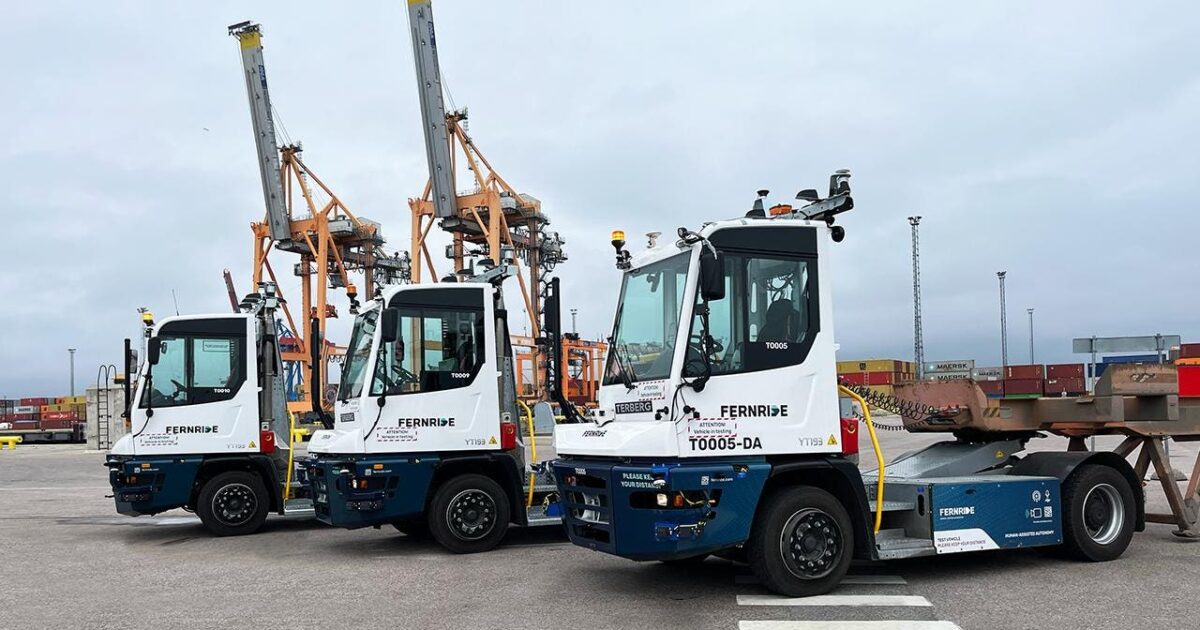FERNRIDE Launches Driverless Operations At HHLA TK Estonia Seaport

FERNRIDE, the European pioneer in yard truck automation, announced today that it has begun the … More
FERNRIDE, the European pioneer in yard truck automation, announced today that it has begun the transition to driverless operation of terminal tractors. This is occurring at the sprawling HHLA TK Estonia logistics terminal, which is situated on the Baltic Sea near Tallinn. Together, the two companies aim to set new standards for safety and efficiency in port logistics by leveraging driverless technology.
In contrast to driverless freight runs on highways and streets, yard trucks operate on pavement within industrial facilities, moving trailers and/or containers.
FERNRIDE offers a human-assisted autonomy approach to this use case, which allows for remote takeovers of trucks when necessary. This ensures seamless integration and reliable operations for logistics operators. With over a decade of research and high-profile customers, including Volkswagen, HHLA, and DB Schenker, FERNRIDE applies technology to address significant industry challenges, such as driver shortages and the negative environmental impact of logistics operations. The company was founded by Hendrik Kramer, Maximilian Fisser, and Jean-Michael Georg and currently has over 150 employees. Founded in 2020, FERNRIDE has raised more than 60M USD in venture funding.
In the Estonian seaport of Muuga, near the capital Tallinn, HHLA operates the multipurpose terminal HHLA TK (Transiidikeskuse) Estonia. The company handles general, bulk and ro-ro cargo and is connected to the international rail network.
Certification: The Key To Opening Market Opportunity in Europe
Fernride’s transition to driverless operations follows the successful certification of FERNRIDE’s safety concept and system design by TÜV SÜD, as well as approval by the Estonian Transport Administration (ETA).
In fact, FERNRIDE notes that it is the first company to receive TÜV SÜD certification for an autonomous terminal tractor in accordance with the EU Machinery Directive (2006/42/EC).
TÜV SÜD has been front and center in providing external safety assessments for Automated Driving System developers. On-road truck automation players Aurora and Gatik, among others, have used their services as a key step in moving to driverless operations. But the nature of a TÜV SÜD assessment can vary widely, depending on what the client asks for. In discussions with FERNRIDE for this story, I sought to know more about the level of thoroughness the evaluation entailed.
FERNRIDE asked TÜV SÜD for a holistic approach. The types of assessments conducted by TÜV SÜD covered the entire system, not just individual modules. The analysis encompassed the vehicle, sensors, computing hardware, software, and cybersecurity with respect to ISO 3691-4 (driverless trucks), ISO 12100 (risk assessment and safety), ISO 13849 (functional safety), and IEC TS 63074 (security for functional safety). In addition, the certification included FERNRIDE’s safety concept and system design, and full testing of the autonomous terminal tractor. TÜV SÜD confirmed that the whole system meets the European Machinery Directive (2006/42/EC), which defines uniform health and safety requirements for machinery and equivalent products for free trade within the European Economic Area.
According to Benedikt Pulver, Head of the Machine Safety Department at TÜV SÜD, this is the first TÜV SÜD certification for a driverless truck for horizontal container transport worldwide. This sets a new benchmark for autonomous terminal tractors.
To get to this point was not a trivial process. To achieve this level of safety certification, FERNRIDE ran extensive tests. The engineers performed over 2.8 million automated software tests every week and up to 80 physical test scenarios per day on real vehicles. They also conducted 1,200 full-system design validation tests to check the entire system as well as more than 4,800 software test cases to cover edge conditions like object behavior, sensor issues, traffic rules, and stress tests for safety and security. These activities occurred over two years of daily operations at customer sites, verifying that the system worked safely in a real terminal environment.
But more approvals were necessary. HHLA TK Estonia requested approval from ETA to run driverless operations. The ETA reviewed the safety functions built into the FERNRIDE system and the full test reports, which TÜV SÜD had already assessed. The ETA concluded that FERNRIDE’s product meets the required safety level for driverless operation in the HHLA TK Estonia port.
What does all this mean? FERNRIDE can now market its product in the European single market and internationally. Customers can buy their vehicles and services as CE-marked container handling equipment, meeting all required safety and procurement standards.
Hendrik Kramer, FERNRIDE CEO, said “This is a defining moment not only for FERNRIDE but for the entire autonomous logistics industry in Europe. From day one, we’ve made safety the foundation of everything we build. Meeting Europe’s most stringent regulatory standards took a remarkable effort, and I’m incredibly proud of our team’s dedication and precision throughout this journey. This certification proves that our technology meets the highest safety benchmarks, not just in theory, but in practice, and brings us one step closer to making autonomous logistics a commercial reality across the EU.”
Riia Sillave, CEO of HHLA TK Estonia, added that “Entering the phase of driverless terminal transport marks a significant milestone – not just for our collaboration with FERNRIDE, but for the future of terminal operations. As one of the first terminals to take this step, we are shaping the path toward a more intelligent and efficient logistics. We trust that innovation succeeds by including the know-how of our employees – our team’s engagement is the foundation for the integration of this technology into everyday operations.”
Noting that FERNRIDE is the first to receive TÜV SÜD certification for a specific port application involving autonomous trucks, Benedikt Pulver, head of the machine safety department at TÜV SÜD, emphasized that “This milestone could establish a new benchmark for safety and compliance in autonomous trucking for terminal applications.”
FERNRIDE and HHLA have had an ongoing partnership since early 2023, working closely to ensure a seamless transition into live operations, executing productive moves on the terminal. The strategy focuses on implementing a gradual approach to integrate FERNRIDE-enabled autonomous terminal tractors at HHLA TK Estonia without safety drivers. Three FERNRIDE tractors are currently in operation at the terminal. FERNRIDE has implemented structured roll-out scenarios and standard procedures to train on-site personnel through the transition to fully driverless operations.
Bottom Line
FERNRIDE characterizes this achievement as “a significant milestone for autonomous logistics in Europe.” They are not alone in this space. Competitors Forterra, ISEE, and Outrider are highly active in the U.S. and in some cases are working with European yard truck manufacturers.
The market for yard trucks is substantial. Success for any one of the players, as well as the end-users, constitutes a rising tide for industrial autonomy.
Disclosure: Richard Bishop is an Advisor to and/or an equity holder in the following companies mentioned in this article: Aurora, Forterra, Gatik, Outrider.

